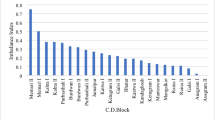Summary
Six profiles from a representative area in the southern part of the deltaic region of Gangetic West Bengal, India, were examined. Of these, one can be termed as normal, another as non-saline alkali, and the remaining four as saline alkali. Of the saline alkali ones, there was one profile which had a rather low pH. The acidic condition of the soil is due to the presence of decaying organic matter in the soil giving rise to what has been termed as a degraded saline alkali soil. In designating the soils as such, the broad conditions of total soluble salts expressed as percentage of sodium chloride per hundred grams of soil and the exchangeable sodium percentage have been used as the criterion. The soils have thus been classified taking into consideration the dominant soil-forming factors active here. Remedial measures to improve these soils include the incorporation of green-manuring crops and the application of soil ameliorants like lime, gypsum and sometimes other chemical amendments. The soils must be surveyed in order to delineate the types of salt-affected soils, and during reclamation, drainage and irrigation measures should not be lost sight of either.
Similar content being viewed by others
References
Agarwal, R. R. and Yadav, J. S. P., Diagnostic techniques for the saline and alkali soils of the Indian Gangetic alluvium in Uttar Pradesh. J. Soil Sci.7 109–21 (1956).
Fireman, M. and Reeve, R. C., Some characteristics of saline and alkali soils in Gem County, Idaho. Soil Sci. Soc. Am. Proc.13, 494–8 (1948).
Fireman, M. and Wadleigh, C. H., A statistical study of the relation between pH and the exchangeable sodium percentage of Western soils. Soil Sci.71 272–85 (1951).
Handbook of Agriculture 1954. No. 60, U.S. Dept. Agr., U.S. Soil Salinity Lab. Staff. L. A. Richards, Editor (1954).
Kelley, W. P., Alkali Soils — Their Formation, Properties and Reclamation. Reinhold Publishing Corpn., New York, U.S.A. Pp. 56 (1951).
Mohr, E. C. J., The Soils of Equatorial Regions. Edwards Brothers, Inc., Ann Arbor, Michigan, U.S.A. (1944).
Piper, C. S., Soil and Plant Analysis. Interscience Publishers, Inc. New York (1950).
Richards, L. A., Chemical and physical characteristics of saline and alkali soils of Western United States. Trans. Intern. Cong. Soil Sci. 4th Congr. Amsterdam1 378–83 (1950).
Van Beekom, C. W. C., Van den Berg, C., De Boer, Th. A., Westerhof, J. J and Zuur, A. J., Reclaiming land flooded with salt water. Neth. J. Agr. Sci.1 1–31 (1953).
Van den Berg, C., The influence of adsorbed salts on growth and yield of agricultural crops on salty soils. The inundations of 1944–45 in the Netherlands and their effect on agriculture. Verslag. Landbouwk. Onderzoek.58.5. Pp. 118 (1952).
Zuur, A. J., Drainage and reclamation of lakes and of the Zuiderzee. Soil Sci.74 75–89 (1952).
Author information
Authors and Affiliations
Rights and permissions
About this article
Cite this article
Banerjee, S. Some studies of salt-affected soils of Canning, West Bengal. Plant Soil 10, 207–219 (1959). https://doi.org/10.1007/BF01416368
Received:
Revised:
Issue Date:
DOI: https://doi.org/10.1007/BF01416368



